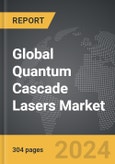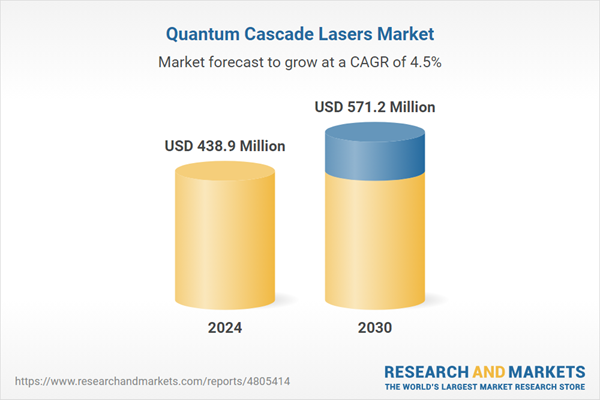The global market for Quantum Cascade Lasers was valued at US$438.9 Million in 2024 and is projected to reach US$571.2 Million by 2030, growing at a CAGR of 4.5% from 2024 to 2030. This comprehensive report provides an in-depth analysis of market trends, drivers, and forecasts, helping you make informed business decisions. The report includes the most recent global tariff developments and how they impact the Quantum Cascade Lasers market.
Technological advancements have significantly enhanced the performance and versatility of quantum cascade lasers. Innovations in material science and fabrication techniques have led to improvements in the efficiency, power output, and wavelength range of QCLs. Developments in quantum well engineering and waveguide design have enabled the production of lasers with high beam quality and stability. Additionally, the integration of QCLs with advanced electronic and optical systems has expanded their applications in fields such as medical diagnostics, defense, and telecommunications. For example, in medical diagnostics, QCLs are used in non-invasive breath analysis to detect biomarkers for various diseases. In defense, they serve as key components in infrared countermeasure systems and secure communication links. The ability to operate at room temperature and the miniaturization of QCL systems have further broadened their practical use in portable and field-deployable devices.
The growth in the quantum cascade lasers market is driven by several factors, including increasing demand for advanced chemical sensing technologies, rising investments in defense and security applications, and continuous advancements in QCL technology. The growing emphasis on environmental monitoring and industrial process control has spurred the adoption of QCL-based sensing systems due to their high sensitivity and selectivity. Investments in defense technologies have also boosted the demand for QCLs in applications such as infrared countermeasures and secure communication. Additionally, advancements in fabrication and material technologies have improved the performance and reduced the cost of QCLs, making them more accessible for a variety of applications. The healthcare sector's interest in non-invasive diagnostic tools has further propelled market growth, as QCLs enable precise detection of disease biomarkers through breath analysis. Furthermore, the expanding scope of QCL applications in emerging fields like quantum computing and communication underscores the potential for sustained market expansion driven by technological innovation and diverse end-use requirements.
Segments: Packaging Type (C-Mount, HHL & VHL Package, TO3 Package); Operation Mode (Continuous Wave, Pulsed); Fabrication Technology (Distributed Feedback, Fabry-Perot, Tunable External Cavities); End-Use (Industrial, Healthcare, Telecommunications, Military & Defense, Other End-Uses).
Geographic Regions/Countries: World; USA; Canada; Japan; China; Europe; France; Germany; Italy; UK; Rest of Europe; Asia-Pacific; Rest of World.
The analysts continuously track trade developments worldwide, drawing insights from leading global economists and over 200 industry and policy institutions, including think tanks, trade organizations, and national economic advisory bodies. This intelligence is integrated into forecasting models to provide timely, data-driven analysis of emerging risks and opportunities.
Global Quantum Cascade Lasers Market - Key Trends & Drivers Summarized
Quantum cascade lasers (QCLs) are semiconductor lasers that emit light in the mid- to far-infrared portion of the electromagnetic spectrum. Unlike conventional semiconductor lasers, which rely on electron-hole recombination to produce light, QCLs utilize intersubband transitions within the conduction band of a semiconductor multiple quantum well structure. This unique mechanism allows for the emission of light at specific, tunable wavelengths determined by the engineering of the quantum wells. Due to their ability to produce coherent radiation over a wide range of wavelengths, QCLs are invaluable in applications such as spectroscopy, chemical sensing, and environmental monitoring. Their precision and tunability make them particularly suited for detecting trace gases and pollutants, where specificity and sensitivity are critical.Technological advancements have significantly enhanced the performance and versatility of quantum cascade lasers. Innovations in material science and fabrication techniques have led to improvements in the efficiency, power output, and wavelength range of QCLs. Developments in quantum well engineering and waveguide design have enabled the production of lasers with high beam quality and stability. Additionally, the integration of QCLs with advanced electronic and optical systems has expanded their applications in fields such as medical diagnostics, defense, and telecommunications. For example, in medical diagnostics, QCLs are used in non-invasive breath analysis to detect biomarkers for various diseases. In defense, they serve as key components in infrared countermeasure systems and secure communication links. The ability to operate at room temperature and the miniaturization of QCL systems have further broadened their practical use in portable and field-deployable devices.
The growth in the quantum cascade lasers market is driven by several factors, including increasing demand for advanced chemical sensing technologies, rising investments in defense and security applications, and continuous advancements in QCL technology. The growing emphasis on environmental monitoring and industrial process control has spurred the adoption of QCL-based sensing systems due to their high sensitivity and selectivity. Investments in defense technologies have also boosted the demand for QCLs in applications such as infrared countermeasures and secure communication. Additionally, advancements in fabrication and material technologies have improved the performance and reduced the cost of QCLs, making them more accessible for a variety of applications. The healthcare sector's interest in non-invasive diagnostic tools has further propelled market growth, as QCLs enable precise detection of disease biomarkers through breath analysis. Furthermore, the expanding scope of QCL applications in emerging fields like quantum computing and communication underscores the potential for sustained market expansion driven by technological innovation and diverse end-use requirements.
Report Scope
The report analyzes the Quantum Cascade Lasers market, presented in terms of units. The analysis covers the key segments and geographic regions outlined below.Segments: Packaging Type (C-Mount, HHL & VHL Package, TO3 Package); Operation Mode (Continuous Wave, Pulsed); Fabrication Technology (Distributed Feedback, Fabry-Perot, Tunable External Cavities); End-Use (Industrial, Healthcare, Telecommunications, Military & Defense, Other End-Uses).
Geographic Regions/Countries: World; USA; Canada; Japan; China; Europe; France; Germany; Italy; UK; Rest of Europe; Asia-Pacific; Rest of World.
Key Insights:
- Market Growth: Understand the significant growth trajectory of the C-Mount segment, which is expected to reach US$242.0 Million by 2030 with a CAGR of a 3.7%. The HHL & VHL Package segment is also set to grow at 5.7% CAGR over the analysis period.
- Regional Analysis: Gain insights into the U.S. market, valued at $239.8 Million in 2024, and China, forecasted to grow at an impressive 5.1% CAGR to reach $22.9 Million by 2030. Discover growth trends in other key regions, including Japan, Canada, Germany, and the Asia-Pacific.
Why You Should Buy This Report:
- Detailed Market Analysis: Access a thorough analysis of the Global Quantum Cascade Lasers Market, covering all major geographic regions and market segments.
- Competitive Insights: Get an overview of the competitive landscape, including the market presence of major players across different geographies.
- Future Trends and Drivers: Understand the key trends and drivers shaping the future of the Global Quantum Cascade Lasers Market.
- Actionable Insights: Benefit from actionable insights that can help you identify new revenue opportunities and make strategic business decisions.
Key Questions Answered:
- How is the Global Quantum Cascade Lasers Market expected to evolve by 2030?
- What are the main drivers and restraints affecting the market?
- Which market segments will grow the most over the forecast period?
- How will market shares for different regions and segments change by 2030?
- Who are the leading players in the market, and what are their prospects?
Report Features:
- Comprehensive Market Data: Independent analysis of annual sales and market forecasts in US$ Million from 2024 to 2030.
- In-Depth Regional Analysis: Detailed insights into key markets, including the U.S., China, Japan, Canada, Europe, Asia-Pacific, Latin America, Middle East, and Africa.
- Company Profiles: Coverage of players such as Emerson Electric Company, Newport Corporation, Hamamatsu Photonics KK, Edmund Optics, Inc., Block Engineering and more.
- Complimentary Updates: Receive free report updates for one year to keep you informed of the latest market developments.
Some of the 46 companies featured in this Quantum Cascade Lasers market report include:
- Emerson Electric Company
- Newport Corporation
- Hamamatsu Photonics KK
- Edmund Optics, Inc.
- Block Engineering
- Boston Electronics Corporation
- Alpes Lasers SA
- mirSense SA
- nextnano GmbH
- Electronics and Telecommunications Research Institute (ETRI)
- Lytid
- Allied Scientific Pro
- Analog Technologies, Inc.
- IRsweep
- LongWave Photonics
Tariff Impact Analysis: Key Insights for 2025
Global tariff negotiations across 180+ countries are reshaping supply chains, costs, and competitiveness. This report reflects the latest developments as of April 2025 and incorporates forward-looking insights into the market outlook.The analysts continuously track trade developments worldwide, drawing insights from leading global economists and over 200 industry and policy institutions, including think tanks, trade organizations, and national economic advisory bodies. This intelligence is integrated into forecasting models to provide timely, data-driven analysis of emerging risks and opportunities.
What’s Included in This Edition:
- Tariff-adjusted market forecasts by region and segment
- Analysis of cost and supply chain implications by sourcing and trade exposure
- Strategic insights into geographic shifts
Buyers receive a free July 2025 update with:
- Finalized tariff impacts and new trade agreement effects
- Updated projections reflecting global sourcing and cost shifts
- Expanded country-specific coverage across the industry
Table of Contents
I. METHODOLOGYII. EXECUTIVE SUMMARY2. FOCUS ON SELECT PLAYERSIII. MARKET ANALYSISREST OF WORLDIV. COMPETITION
1. MARKET OVERVIEW
3. MARKET TRENDS & DRIVERS
4. GLOBAL MARKET PERSPECTIVE
UNITED STATES
CANADA
JAPAN
CHINA
EUROPE
FRANCE
GERMANY
ITALY
UNITED KINGDOM
REST OF EUROPE
ASIA-PACIFIC
Companies Mentioned (Partial List)
A selection of companies mentioned in this report includes, but is not limited to:
- Emerson Electric Company
- Newport Corporation
- Hamamatsu Photonics KK
- Edmund Optics, Inc.
- Block Engineering
- Boston Electronics Corporation
- Alpes Lasers SA
- mirSense SA
- nextnano GmbH
- Electronics and Telecommunications Research Institute (ETRI)
- Lytid
- Allied Scientific Pro
- Analog Technologies, Inc.
- IRsweep
- LongWave Photonics
Table Information
| Report Attribute | Details |
|---|---|
| No. of Pages | 304 |
| Published | April 2025 |
| Forecast Period | 2024 - 2030 |
| Estimated Market Value ( USD | $ 438.9 Million |
| Forecasted Market Value ( USD | $ 571.2 Million |
| Compound Annual Growth Rate | 4.5% |
| Regions Covered | Global |









